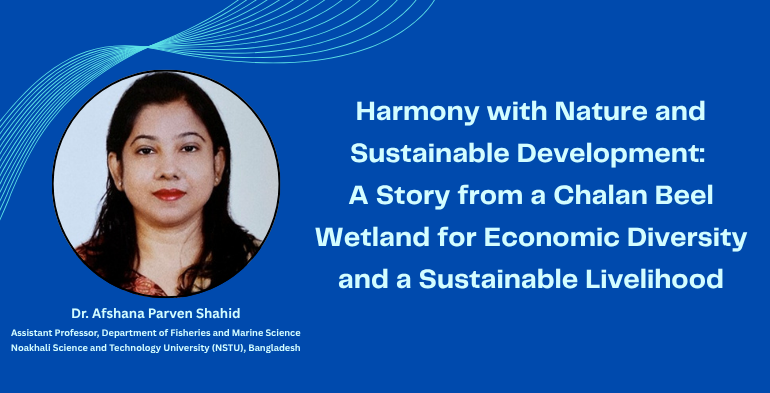
By Dr. Afshana Parven Shahid:Birdsong fills the air as the sun rises over the expansive waters of Chalan Beel, illuminating the silvery surface of the marsh. Local communities have depended on this intricate ecosystem—the largest wetland in northwest Bangladesh—for farming, fishing, and gathering aquatic plants for years. In recent times, unplanned development and environmental degradation have posed significant threats to the balance of ecosystems and the livelihoods of many. In response, a quiet transformation has begun driven not by top-down interventions but by local communities choosing to coexist harmoniously with nature. This writing explores resilience, adaptation, and sustainable development emerging from the heart of Chalan Beel.
Chalan Beel: A Vital Ecosystem Under Stress
Chalan Beel encompasses 350 sq. km during the monsoon and spans parts of Natore, Pabna, and Sirajganj districts. It functions as a crucial floodplain, a habitat for fish, and a seasonal refuge for migratory birds. The beel supports the livelihoods of over 300,000 people who rely on it for fishing, agriculture, duck farming, and collecting aquatic vegetation.
However, overfishing, siltation, the use of agrochemicals, the construction of roads and embankments, and the decline in monsoon rainfall have steadily reduced the productivity of the wetland. Indigenous fish species, such as Baim, Shing, Tengra, Puti, Chanda, etc. are in decline. Invasive weeds (water hyacinth) clog the waterways, and the once-plentiful waterfowl are now a rare sight. As climate change further disrupts rainfall patterns and water availability, the vulnerabilities of the wetland communities have deepened. Poverty, food insecurity, and seasonal unemployment are common. Many young people migrate to cities in search of employment, leaving behind aging populations and fragile local economies.
Community Awakening: Embracing the Wetland's Wisdom
In 2016, a group of local fishers and farmers from Gurudaspur Upazila in Natore came together to discuss potential solutions. Supported by a civil society initiative—Beel Vabon Unnayan Sangstha (BVUS)—and in collaboration with researchers from Rajshahi University, they began reimagining a development model that would be ecologically sensitive and economically viable. Their guiding principle was simple: "Nature is not an obstacle to overcome but a partner to collaborate with." The movement emphasized four key pillars:
- Wetland-friendly livelihoods
- Community-based resource management
- Ecological restoration
- Knowledge sharing and participatory governance
This approach aligns with the global principles of the Sustainable Development Goals (SDGs), particularly SDG 1 (No Poverty), SDG 2 (Zero Hunger), SDG 13 (Climate Action), and SDG 15 (Life on Land).
Economic Diversity Rooted in Ecology
Capture fisheries and agriculture are the main livelihoods for the locals, but over time, the community has explored a range of alternative livelihoods, including crop diversification.
Integrated Rice-Fish Farming: By modifying paddy fields to hold water longer, the community looked at various alternate sources of income to overcome their over-reliance on capture fishing.
- Integrated Rice-Fish Farming: Farmers enhanced rice and fish harvests without using chemicals by altering paddy fields to retain water longer and adding native fish species, such as Puti and other small fish when the water is waterlogged, and rice is grown together. In addition to increasing revenues, integrated farming also enhances nutrition. Integrated agriculture not only boosted incomes but also improved nutrition.
- Floating Gardens (Baira Cultivation): Inspired by practices in the southern wetlands of Bangladesh, floating gardens made of water hyacinth and bamboo were introduced to grow vegetables such as okra, leafy greens, and tomatoes. Women's groups managed many of these gardens, providing income and empowerment. Unfortunately, this is not a common practice in the Chalan Beel area; however, very few households use it near their open water bodies for personal vegetable production.
- Duck Rearing and Eco-Tourism: Duck farming gained popularity with the return of migratory birds and improved water quality. Some community members also began offering boat tours and birdwatching trips, opening new avenues for eco-tourism.
- Handicrafts from Wetland Plants: Craftspeople used kash and hogla grasses to make mats, baskets, and hats for local markets and NGOs. Craftsmen and women revived cultural heritage while utilizing sustainable resources.
Reviving the Wetland Through Participatory Management
Rather than waiting for government interventions, the communities took the lead in wetland restoration. Youth volunteers removed invasive aquatic weeds and cleared clogged waterways to restore water flow. Traditional fish sanctuaries, known as jal mahals, were revived, with local committees overseeing fishing practices to prevent overharvesting and ensure breeding periods.
A local wetland management council comprised elders, farmers, fishers, women leaders, and youths. The council operated on consensus and liaised with government departments for technical support.
"Before, we only thought about survival. Now we think about sustainability," says Amena Khatun, a local cultivator. She also said, "We see the wetland as our home, not just a source of income/seasonal income." Mr. Meherul Islam Badaol, a senior journalist and local college professor, also mentioned various conservation activities in the wetland. Many indigenous fish species are no longer as abundant as they were in the past due to the use of fishing crafts and gear, such as the illegal China Duari fishing net. Duck rearing is also profitable in this area; when the water level declines, the ducks graze in the open water body, minimizing feeding costs.
Additionally, local people harvest the apple snail for ducks or sell the snail sacks at a high price to collectors, who then send them to different parts of the country. Due to their negligence, the environment and ecosystem in that area are threatened. He also mentioned that the Chalan bill is at the heart of food production and storage in North Bengal. The government must take the initiative to protect the ecosystem, biodiversity, and livelihoods of this area.
Women at the Center of Change
The role of women has significantly increased in wetland management. Traditionally marginalized in decision-making, women are now at the forefront of initiatives such as floating gardens and backyard cooperatives, savings groups, and water-user committees.
Women from Gurudaspur explain, "We used to depend on men going to towns for work. But now, with vegetable farming and duck rearing, we earn enough to keep our children in school and save for emergencies." Their activities increase the girls' school retention and reduce the number of child marriages. Still, the Chalan Beel area is one of the locations where child marriage and gambling are prevalent and not considered a social crime.
Insights for More Comprehensive Sustainability
The Chalan Beel venture has difficulties. Threats still include encroachment, climate shocks, and inadequate institutional cooperation. Yet, the transformation provides a model for how community-driven, nature-based solutions can be effective even in highly vulnerable regions.
Researchers from the Bangladesh Centre for Advanced Studies (BCAS) and the International Union for Conservation of Nature (IUCN) have documented the Chalan Beel case as a replicable example of Community-Based Wetland Management (CBWM).
Their recommendations include:
- Recognition of wetland commons under law
- Integration of traditional ecological knowledge into formal conservation
- Micro-credit and training support for eco-livelihoods
- Climate-resilient infrastructure development
Looking Ahead: A Shared Future
In the 1990s, Chalan Beel produced single crops, but over time, crop diversity has increased. There are two crops in a year. During the Robi season, the Chala beel resembles a yellow bed due to mustard cultivation, which produces honey as a by-product and a means of livelihood for many people. On the other hand, when monsoon water increases, boro cultivation continues. However, the story of Chalan Beel is inspiring in a time of ecological uncertainty. The climate crisis, including natural disasters such as floods and droughts, is escalating, but the monsoon has been delayed. Rural communities face growing income uncertainties. The people of this wetland remind us that sustainable development is not only about GDP growth or high-tech interventions. It is about respecting the rhythms of nature, empowering communities, and building resilience from the ground up.
As dusk falls over the beel and the water glows under the fading sun, social awareness has increased to restore the land, water, and their future. According to the locals, "If we take care of the wetland, it will take care of us." In a conclusive sentence, SDGs 1, 2, 13, and 15 will be achieved if the wetland is appropriately managed and livelihood diversification is achieved. Thus, users, other stakeholders, civil society, and government should act together to reduce bureaucracy and interdepartmental gaps for sustainable ecological growth and survival.
Writer: Assistant Professor, Department of Fisheries and Marine Science, Noakhali Science and Technology University (NSTU), Bangladesh.
























